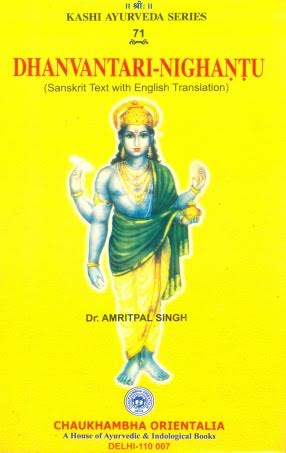When and Where Was it Written?
The Nighaṇṭu Period (approximately 700 C.E. to 1498 C.E.) witnessed the development of several compendia on the identification and therapeutic properties of medicinal substances. The Dhanvantari Nighaṇṭu is believed to have been written towards the latter part of the Nighaṇṭu Period, around the 13th century C.E. and after. It is often confused with the 10th century C.E. work Dravyavali (this text is no longer available) because it too starts with a salutation to the Lord Dhanvantari. The earlier works of the Nighaṇṭu Period focused more on the identification and synonyms of drugs, while the later works seem to have dived into greater details like therapeutic properties of the drugs. Academics believe that the content of Dravyavali has been absorbed into the current version of Dhanvantari Nighaṇṭu: the portions that list synonyms of drugs are assumed to be from Dravyavali, while the portions that deal with properties and actions of drugs are from the original Dhanvantari Nighaṇṭu.
The exact location within India where the Dhanvantari Nighaṇṭu was written is not known.
About the Author or Lack Thereof
One of the difficulties one encounters when attempting to assign authorship of texts like Dhanvantari Nighaṇṭu is that the authors specifically wished not to be identified. It was considered preferable for the text to be attributed directly to Lord Dhanvantari himself, composed before time was time, than to be the work of a mere mortal. As it is, Dhanvantari Nighaṇṭu is considered the most ancient of the nighaṇṭu texts according to Pushpan et al, and its human author is unknown.
How Is It Organized?
The plants are divided into seven groups, called vargas, named for the star herb in that group. Each varga has a distinct set of medicinal properties. There is short mention of each herb, with the Sanskrit name, the Latin name, other common names, a list of taste and qualities, and what medicinal properties the herb provides. There is no more than a paragraph for each herb. The first group, the Guduchyadivarga, is named for the herb guduchi, and is used for curing diseases of the upper and middle parts of the body. The Shatapushpadivarga is named for the herb shatapushpa, or dill. They are used as appetizers (to stimulate digestion), as tonics and to freshen the breath. The Chandanadivarga is named for the herb chandan, or sandalwood. They are aromatic herbs and are of use for those with lavish budgets, and include female infertility and many skin diseases. The Karaviradivarga is named for the herb karavira. It’s used for the treatment of various diseases, including skin diseases, poisoning and parasitical infections. The Amaradivarga is named for amra, the mango, and is used for boosting strength, complexion and appetite, as well as curing specific conditions. The majority of plants are used for their fruit, bark or flowers. The Suvaranadivarga is named for suvarna, gold. It includes metals, mercury and coral ash preparations, as well as grains like barley and meats, and treats many conditions. The Mishrakadivarga includes classical herbal mixtures and formulations like trikatu, which contains black pepper, pippali and dried ginger.
What Makes it Different From Other Nighantu Texts?
Among the Nighaṇṭu texts, Dhanvantari Nighaṇṭu stands out in that it is is one of the oldest and most referenced texts, providing a distinctive categorization of 373 drugs. Moving beyond earlier works such as Astanga Nighaṇṭu, Nidana or Rogaviniscaya, Dhanvantari Nighaṇṭu deals with the unique properties, actions, incompatibilities and safety of individual drugs in addition to listing synonyms. In addition, while 88 of the drugs listed are of plant origin, Dhanvantari Nighaṇṭu was among the first texts to list drugs of non-plant origin: 2 are of kshara (alkali preparation) and 2 are lavana (salts) followed by 11 drugs of mineral origin, 24 drugs are of animal origin, 9 belong to alcoholic preparations and 4 belong to jala varga. Other examples of differences include drugs listed in prior texts but not in Dhanvantari Nighaṇṭu and vice-versa. The numbers of synonyms in prior texts versus in Dhanvantari Nighaṇṭu also differ.
This Nighantu As it Relates to Present day Ayurveda
As Dhanvantari Nighaṇṭu was the first of its kind, it set the gold standard; it is the primary source of information on Ayurvedic herbs. Its use is invaluable in the education of Ayurvedic practitioners and indispensable to the practicing physician, despite several more comprehensive glossaries that have been compiled since.
Nowadays people have taken it upon themselves to write a lot of herbology books, those books are secondary or tertiary sources. Where did people get the information for those books? What was the first nighaṇṭu that started putting in information above and beyond synonyms? Dhanvantari Nighaṇṭu. Nighaṇṭu are so important, that’s why we have a whole class about it. We want to create experts in nighaṇṭu.
- Alakananda Ma, Alandi Ayurveda Gurukula.
Sources
- Singh, Amritpal [Tr]. Dhanvantari-Nighantu. Chaukhambha Publishers: Varanasi, 2008.
- Anagha Ranade, Rabinarayan Acharya (2015), CONTRIBUTION OF DHANWANTARI NIGHANTU TOWARDS DRUG SAFETY: A CRITICAL REVIEW, Global J Res. Med. Plants & Indigen. Med., Volume 4(2): 20–29
- Sharma, P. V. (1970), THE DATE OF DHANWANTARI NIGHANTU. Department of Dravyaguna, Postgraduate Institute of Indian Medicine, Banaras hindu University, Varanasi 5

